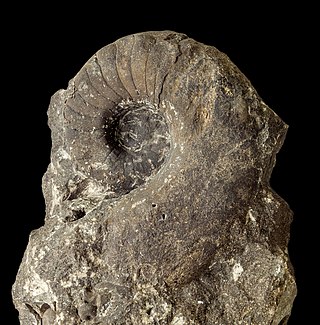Related Research Articles

Lituites is an extinct nautiloid genus from the Middle Ordovician and type for the Lituitidae that in some more recent taxonomies has been classified with the orthocerids and listed under the order Lituitida. Fossils have been found in New York, Argentina, Norway, Sweden, Estonia, and China.
Rayonnoceras is a genus of extinct cephalopods that lived around 325 million years ago during the Carboniferous. Although they resemble earlier actinocerids they are now thought to belong to the Pseudorthocerida
Homaloceras is an extinct nautiloid cephalopod from the Middle Devonian with a strongly curved shell, included in the nautilid family Centroceratidae.
Ulrichoceras is recognised as the basal cyrtogomphoceratid genus, which is the source for the rest of the Cyrtogomphoceratidae as well as for the Westonoceratidae. The Cyrtogomphoceratidae are endogastric, the Westonoceratidae, exogastric.
Westonoceras is an extinct nautiloid genus from the Discosorida that lived during the Middle and Late Ordovician that has been found in North America, Greenland, and Northern Europe. It is the type genus for the Westonoceratidae
Tylonautilus is an extinct genus in the nautiloid order Nautilida from the Lower Carboniferous of Europe and Permian of Japan.
Trigonoceras is an extinct genus of prehistoric nautiloids from the nautilid family Trigonoceratidae that lived during the Early Carboniferous in what is now western Europe.
The Bassleroceratidae is a family of gradually expanding, smooth ellesmerocerids with a slight to moderate exogastric curvature, subcircular to strongly compressed cross section, and ventral orthochaonitc siphuncle. The ventral side is typically more sharply rounded than the dorsal side and septa are close spaced. Connecting rings are thick and slightly expanded into the siphuncle, making the segments slightly concave; characteristic of the Ellesmerocerida.
The Centroceratidae is the ancestral family of the Trigonoceratoidea and of the equivalent Centroceratina; extinct shelled cephalopods belonging to the order Nautilida
Aphelaeceras is an extinct genus from the nautilid family Trigonoceratidae which is part of the Trigonocerataceae, that lived during the Mississippian Period in the late Paleozoic.
Bassleroceras is an elongate upwardly curved, exogastric, genus with the venter on the under side more sharply rounded than the dorsum on the upper. The siphuncle is ventral, composed of thick-walled tubular segments in which connection rings thicken in towardly as in both the Ellesmerocerida and primitive Tarphycerida.
Teichertoceras is a discosorid genus in the family Westonoceratidae characterized by an endogastric curvature to the early portion of the phragmocone.
Sceptrites is an orthoceratoid genus contained within the pseudorthocerid family Spyroceratidae known by its slightly compressed, possibly endogastrically curved, cyrtoconic shell. Sceptrites has been found in Devonian sediments in Ohio and N.Y. in the United States and in Victoria, Australia.

Metacoceras is a nautilitoid cephalopod from the Upper Carboniferous (Pennsylvanian) and Permian, the shell of which is moderately evolute with a subquadrate whorl section, bearing nodes on the ventral or umbilical shoulders or both, but otherwise smooth. The siphuncle is small, subcentral and orthochoanitic. The suture has shallow ventral and lateral lobes but no dorsal or annular lobe.
Poterioceratidae is a family of nautiloid cephalopods included in the Oncocerida that lived during the period from the Early Devonian to the Early Carboniferous (Mississippian). Members of the Poterioceratidae are distinguished by a subcircular to compressed exogastric shell that has no hyponomic sinus and a central to subcentral siphuncle composed of subquadrate to nummuloidal segments in which the septal necks are more strongly curved on the upper, or dorsal side. This is opposite from the Karoceratidae in which siphuncle segments are inflated ventrally but straight dorsally. Some poterioceratid genera have actinosiphonate structures or annular deposits within the siphuncle. In others it is empty.

Oocerina is an extinct genus of nautiloid cephalopods that lived during the Late Silurian of Europe, Russia, and North America.
Cyrtogomphoceras is a genus of nautiloid cephalopods, recognized by its large breviconic shell with a notable endogastric curvature. The shell is fusiform in profile, reaching maximum width at or near the base of body chamber, which narrows toward the aperture. The siphuncle is large and slightly removed from the ventral side, that with the concave longitudinal profile. Siphuncle segments are short, as are chambers; septal necks recurved, connecting rings thick, bullettes at the apical end of the rings swollen. Cameral deposits are lacking.
Discosoridae comprise a family of endogastric discosorids, with endocones in the siphuncle, ranging from the Middle Silurian to Middle Devonian.
Karoceras is a genus of oncocerid nautiloids that lived during the Silurian and possibly Early Devonian, type genus for the Karoceratidae. The shell is a compressed, exogastric cyrtocone, section sub ovoid. The siphuncle is ventral, near the outer, externally convex curvature. Septal necks flair outwardly, segments are inflated ventrally and are straight dorsally, a character of the family.
Cyrtocycloceras is a genus of orthocerids from the Middle Silurian of Europe included in the Paraphragmitidae.
References
This article includes a list of references, related reading, or external links, but its sources remain unclear because it lacks inline citations .(August 2012) |
- Walter C. Sweet, 1964. Nautiloidea - Orthocerida. Treatise on Invertebrate Paleontology, Part K. Geological Society of America and University of Kansas Press.
- Bjorn Kroger, 2007. Carboniferous Actinoceroid Nautiloidea (Cephalopoda): a new perspective. Journal of Paleontology, July 2007;